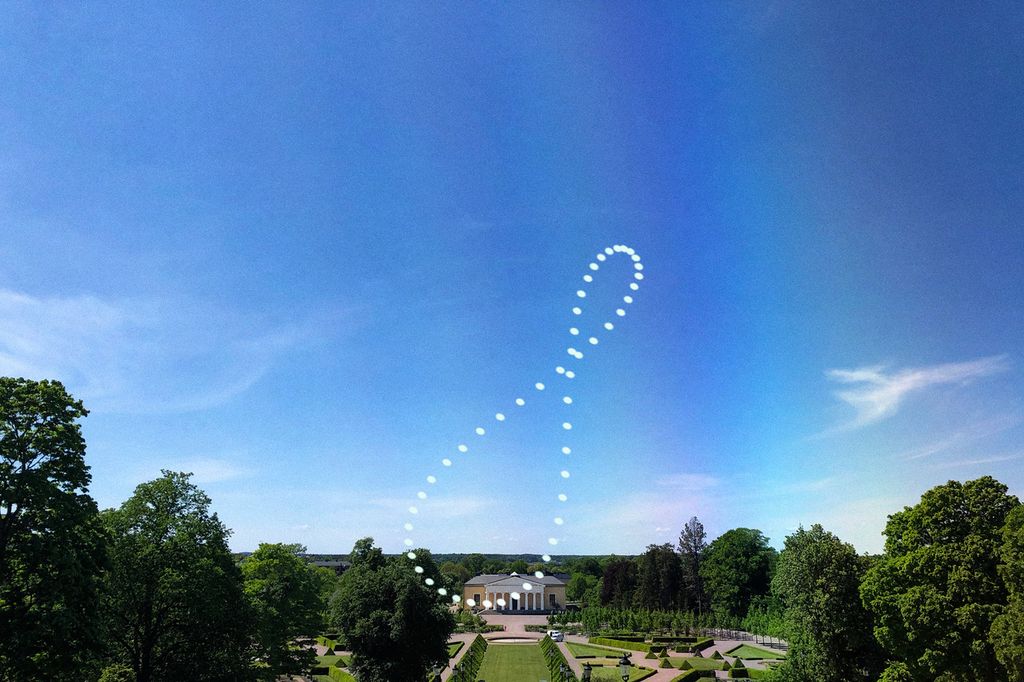I projektet "Time Observatory (del 1)" har konstnären Alvaro Campo skapat en platsspecifik installation på Uppsala slotts borggård. Genom meteorologiska och optiska fenomen, planeters rörelse och växtodling undersöker han hur vi upplever och relaterar till begreppet tid.
Åtta pallkragar bevattnas varje eftermiddag och när solen står i en specifik vinkel uppstår en dimridå av regnbågseffekter. Verket fungerar som en egen klocka som samtidigt utvecklar sig och förändras under sommaren. Med titeln "The Measure of Change" fortsätter utställningen in på museet.
Invigning fredag 26 juni 16.00-16.30 med livesändning och samtal mellan konstnären Alvaro Campo, Rebecka Wigh Abrahamsson, intendent, och Daniel Werkmäster, museichef, Uppsala konstmuseum.
Konstnären Alvaro Campos arbete grundar sig i vardagsnära perception och ett registrerande av ljusets skiftningar, skuggor, årstider och väderfenomen. Skolad i fotografi på ICP i New York, tillhör han de konstnärer som tagit med sig de fotografiska arbetsmetoderna och frågeställningar, men till stor del lämnat den tvådimensionella ytan.
Utställningen "The Measure of Change" spänner över olika media som installationer och teckning. I "Gravity"", en konceptuell performance, bjuds besökaren in att undersöka sin egen gravitation. Ett formalistiskt inslag är även kvadraten som återkommer som en yta för reflektioner, men även i form av en projektionsduk i skogen. "Untitled (Direct cinema / Cinema Vérité)", belyser och ramar in något så enkelt som solglittret mellan träd i skogen. Utställningen har vuxit fram i samtal med forskare inom astronomi, filosofi, biologi och klimatomställning, kring vad tid är och hur vi kan förstå oss själva utifrån naturens processer. Titeln "The Measure of Change" kommer från filosofen Aristoteles tankar att tid är förändring. På samma sätt uppmanas vi här att registrera och relatera våra kroppar till ett större kosmiskt sammanhang. Hur solen och månen styr vår cykliska tid och hur gravitationen drar oss mot marken.
I verket "Eight automated rainbows and the progress of flowers" låter Alvaro Campo växters utveckling i pallkragar vara själva framsteget. I många kulturer är regnbågar en symbol för det gudomliga. Redan 1600-talsfilosofen Renée Descartes visade på den optiska och meteorologiska funktionen när ljusvågorna bryts i vattendroppar och ett prisma uppstår. Descartes levde under ”Den teleskopiska tidsåldern”. Liksom många tidiga vetenskapsmän hade Descartes ett brett intresseområde inom filosofi, matematik och kosmologi och arbetade även som linsslipare. På många sätt liknar Alvaro Campos breda undersökningar dessa vetenskapliga föregångare. Matematiska beräkningar, astronomi och optiska observationer resulterar i konstverk som är öppna för betraktaren. De fångar det flyktiga i nuet och ställer frågor om hur vi vårdar relationen till naturen och allt annat levande.
Alvaro Campo har som del av projektet filmat fyra intervjuer med forskare, i samarbete med Uppsala konstmuseum och Gustavianum, Uppsalas universitetsmuseum som finns att ta del av i utställningen:
Eric Stempels, astronom vid Institutionen för Astronomi och rymdfysik, Uppsala universitet.
Om astronomens perspektiv på begreppet tid.
Erik Hallstensson, doktorand teoretisk filosofi, Uppsala universitet.
Vad händer när samhället saktar ner? Om Covid-19 och samhällets sårbarhet.
Marie Kvarnström, biolog med fokus på biodiversitet, SLU, samt författare.
Om årstiderna, ljuset och mörkret i bondesamhället.
Isak Stoddard, doktorand, Institutionen för Geovetenskaper.
Om geologiskt tid och hur vi kan föreställa oss en klimatneutral framtid?
Eight automated rainbows and the progress of flowers aktiveras genom bevattning dagligen 15.30-16.30 med 10 minuters intervaller.
Lördag 15 augusti under finissage sänds ett sammanfattande panelsamtal där konstnären och forskare medverkar.
Alvaro Campo bor i Stockholm och är född 1972 i Genève, Schweiz. Han är utbildad på ICP International Centre of Photography i New York 1997-1998, samt nyligen på postmaster-kursen Of Public Interest på Kungliga konsthögskolan i Stockholm. Alvaro Campo har genomfört flera gestaltningsuppdrag i Sverige, samt deltagit i flera grupp- och separatutställningar.
Tack till: Uppsala universitet, Statens fastighetsverk, Trädgårdsanläggare Hallblom, Scenteknik, Reginateatern.
*English*
In the project "Time Observatory (part 1)", artist Alvaro Campo has created a site-specific installation for Uppsala Castle's courtyard. Through meteorological and optical phenomena, the movement of planets and growth of plants, he investigates how we experience and relate to the concept of time.
Eight pallet collars are irrigated each afternoon and when the sun is at a specific angle, a rainbow effect arises. The work functions as a clock that develops and changes during the summer. With the title "The Measure of Change" the exhibition continues into the museum.
Opening Friday, June 26, 16: 00-16: 30 with live broadcast and talk between artist Alvaro Campo, Rebecka Wigh Abrahamsson, curator, and Daniel Werkmäster, Museum director, Uppsala Art Museum.
The work of the artist Alvaro Campo is based on everyday perception and a recording of the shifts, shadows, seasons and weather phenomena. Trained in photography at ICP in New York, he belongs to the artists who have brought with them the photographic working methods and issues, but expanded from the two-dimensional surface.
The exhibition "The Measure of Change" covers various media such as installations and drawings. In "Gravity", a conceptual performance, the visitor is invited to explore his own gravity, a formalistic element is also the square that returns as a reflective surface, but also in the form of a projection screen in the forest. "Untitled (Direct cinema / Cinema Vérité) "illuminates and frames something as simple as the glitter between trees in the forest. The exhibition has emerged in discussions with researchers in astronomy, philosophy, biology and climate change, about what time is and how we can understand ourselves based on nature's processes. The title "The Measure of Change" comes from the philosopher Aristotle's thoughts that time is change itself, and in this way we are invited to register and relate our bodies to a larger cosmic context. How the sun and moon control our cyclic time and how gravity pulls us towards the ground.
In the work "Eight automated rainbows and the progress of flowers", Alvaro Campo allows plants' growth in pallet collars to be the progress itself. In many cultures, rainbows are a symbol of the divine. The 17th century philosopher Renée Descartes showed the optical and meteorological phenomena of light waves breaking in water drops and thus creating prisms. In many ways, Alvaro Campo's broad research is similar to those of his scientific predecessors. Mathematical calculations, astronomy and optical observations result in works of art that are open to the viewer. They capture the present moment and ask questions about how we nurture our relationship to nature as whole.
As part of the project, Alvaro Campo has filmed four interviews with researchers, in collaboration with Uppsala Art Museum and Gustavianum, Uppsala University Museum, which can be found in the exhibition:
Eric Stempels, astronomer at the Department of Astronomy and Space Physics, Uppsala University.
About the astronomer's perspective on the concept of time.
Erik Hallstensson, PhD student of theoretical philosophy, Uppsala University.
What happens when society slows down? About Covid-19 and the vulnerability of society.
Marie Kvarnström, biologist with a focus on biodiversity, SLU, and author.
About the seasons, the light and the darkness of the farming community.
Isak Stoddard, PhD student, Department of Earth Sciences.
About geological time and how we can imagine a climate-neutral future?
Eight automated rainbows and the progress of flowers are activated by irrigation daily from 15:00 to 17:00 with intervals.
On Saturday, August 15th during the finissage, a summary panel talk will be sent in which the artist and researchers participate.
Alvaro Campo lives in Stockholm and was born in 1972 in Geneva, Switzerland. He is educated at the ICP International Center of Photography in New York 1997-1998, and most recently at the postmaster course “Of Public Interest” at the Royal College of Art in Stockholm. Alvaro Campo has completed several public commissions in Sweden, and has participated in several group and separate exhibitions.
Thanks to: Uppsala universitet, Statens fastighetsverk, Trädgårdsanläggare Hallblom, Scenteknik, Reginateatern



